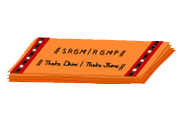Posted By: Administrator
Vandhe Mātharam
Composer:
Bankim Chandra Chatterjee (also
called Bankim Chandra Chattopadhyay)
Language: Sanskrit
Meanings
- Word by word: Team Ambalam
Meanings
- Overall: Sri Aurobindo - http://www.bhavans.info/heritage/vandemataram.asp
Alignment, Diacriticals & consequent spelling changes, Language
& grammar editing, if any and necessary, of existing meaning: Team Ambalam
Vandhe
mātharam
Sujalām
suphalām malayaja śhīthalam,
Sasyaśhyāmalam mātharam!
Śhubhra
jyothsna-pulakitha yāminīm,
phullakusumitha-dhrumadhala śhobhinīm
suhasinīm sumadhhura bhāṣhinīm,
sukhadhām varadhām mātharam!
Thrimśhakoṭikāntha-kalākala-ninādha karāle
dhvithrimśhakoṭi bhujair dhhrutha-khara karāvale
abalā kena ma eta bale!
Bahubaladharinīm, namāmi thārinin,
ripudhalavāriṇīm mātharam!
Thumi vidhyā, thumi dhharma,
thumi hridhi, thumi marma,
thvam hi prāṇah śharire!
Bahuthe thumi mā śhakthi,
hridhaye thume ma bhakthi,
thomari prathimā gari mandhire mandhire !
Thvam he dhurgā daśhapraharaṇa dhhāriṇi,
kamala, kamala-dhala-vihāriṇi,
vāṇi vidhyādhāyini namāmi thvam
namāmi kamalām amalām athulām,
sujalām suphalām mātharam,
vandhe mātharam!
Śhyāmalām, saralām, susmithām, bhūṣhitham,
dharinīm, bharanīm mātharam.
Meaning:
Vandhe mātharam
Vandhe
- I bow to;
mātharam
– mother
I bow to thee, O Mother!
Sujalām suphalām malayaja śhīthalam,
Sasyaśhyāmalam mātharam!
Sujalām
– with abundant water;
Suphalām-
full of fruits;
malayaja
- the winds of the south;
śhīthalam - cool with;
Sasyaśhyāmalam-
dark with the crops;
mātharam!- The mother !
Richly-watered, richly-fruited, cool with the winds of the south,
dark with the crops of the harvests, the mother !
Śhubhra jyothsna-pulakitha yāminīm,
phullakusumitha-dhrumadhala śhobhinīm
suhasinīm sumadhhura bhāṣhinīm,
sukhadhām varadhām mātharam!
Śhubhra
jyothsna- the bright moonlight;
pulakitha
– rejoicing;
yāminīm
– night;
phullakusumitha – flowers in bloom;
dhrumadhala
- trees
śhobhinīm
- shining
suhasinīm – smiling
sumadhhura
bhāṣhinīm- speaking sweetly
sukhadhām – giver of joy
varadhām
– giver of boons
mātharam!
– the mother!
Her nights rejoicing in the glory of the moonlight,
her lands clothed beautifully with her trees in flowering bloom,
sweet of laughter, sweet of speech,
the mother, giver of boons, giver of bliss!
Thrimśhakoṭikanṭha-kalākala-ninādha karāle
dhvithrimśhakoṭi bhujair dhhrutha-khara karāvale
abalā kena ma eta bale!
Bahubaladharinīm, namāmi thārinin,
ripudhalavāriṇīm mātharam!
Thrimśhakoṭi -
kanṭha-kalākala-
noise of the throat;
ninādha
– sounds;
karāle
– fierce;
dhvithrimśhakoṭi-
bhujair dhhrutha-held by the shoulders;
khara
- swords
karāvale
– in the hand
abalā -weak
kena
–by whom?
ma
eta–that you are
bale! -said
Bahubaladharinīm – one who has a lot of strengths;
namāmi – I bow to
thārinin
– one who saves;
ripudhala- army of enemies;
vāriṇīm
– one who drives away;
mātharam!- the mother;
Terrible with the clamorous shout of seventy million throats,
and the sharpness of swords raised in twice seventy million hands,
who sayeth to thee, mother, that thou art weak?
Holder of multitudinous strength, I bow to her who saves,
to her who drives from her the armies of her foemen, the mother!
Thumi vidhyā, thumi dhharma,
thumi hridhi, thumi marma,
thvam hi prāṇah śharire!
Bahuthe thumi mā śhakthi,
hridhaye thume ma bhakthi,
thomari prathimā gari mandhire mandhire !
Thumi vidhyā – you are the knowledge;
thumi dharma – you are the virtue;
thumi hridhi – you are the heart;
thumi marma – you are the secret one inside;
thvam hi – you indeed are;
prāṇah
– the life in; śharire!- the body!
Bahuthe – in the shoulder(arms);
thumi
mā śhakthi – you are the goddess of strength;
hridhaye – in the heart;
thume
ma bhakthi – you are the goddess of devotion
thomari – your; prathimā – image;
gari – to place in;
mandhire mandhire !- in the temples;
Thou art knowledge, thou art conduct,
thou art heart, thou art soul,
for thou art the life in our body.
In the arm thou art might, o mother,
in the heart, o mother, thou art love and faith,
it is thy image we raise in every temple.
Thvam he dhurgā daśhapraharaṇa dhhāriṇi,
kamala, kamala-dhala-vihāriṇi,
vāṇi vidhyādhāyini namāmi thvam
namāmi kamalām amalām athulām,
sujalām suphalām mātharam,
vandhe mātharam!
Thvam
he dhurgā – You are goddess Durga
daśhapraharaṇa
dhhāriṇi – holding the ten weapons of destruction
kamala – the lotus;
kamala-dhala-vihāriṇi
– one who sports in the lotus petals;
vāṇi - speech;
vidhyādhāyini
– giver of knowledge;
namāmi
thvam – I bow to you;
namāmi – I bow to;
kamalām
– the goddess of wealth;
amalām
– pure;
athulām
– incomparable;
Sujalām – with abundant water;
Suphalām-
full of fruits;
mātharam!- The mother !
Vandhe
mātharam – Hail to the mother!
For thou art Durga holding her ten weapons of war,
kamala at play in the lotuses
and speech, the goddess, giver of all lore, to thee i bow!
I bow to thee, goddess of wealth, pure and peerless,
richly-watered, richly-fruited, the mother!
Śhyāmalām, saralām, susmithām, bhūṣhitham,
dharinīm, bharanīm mātharam.
Śhyāmalām – the dark one;
Saralām – the simple one;
Susmithām
– the smiling one;
bhūṣhitham – the bejewelled one;
dharinīm – the one who is adorned;
bharanīm
– One who is prosperous;
mātharam
– the mother!
I bow to thee, other, dark-hued, candid,
Sweetly smiling, jewelled and adorned,
the holder of wealth, the lady of plenty, the mother












